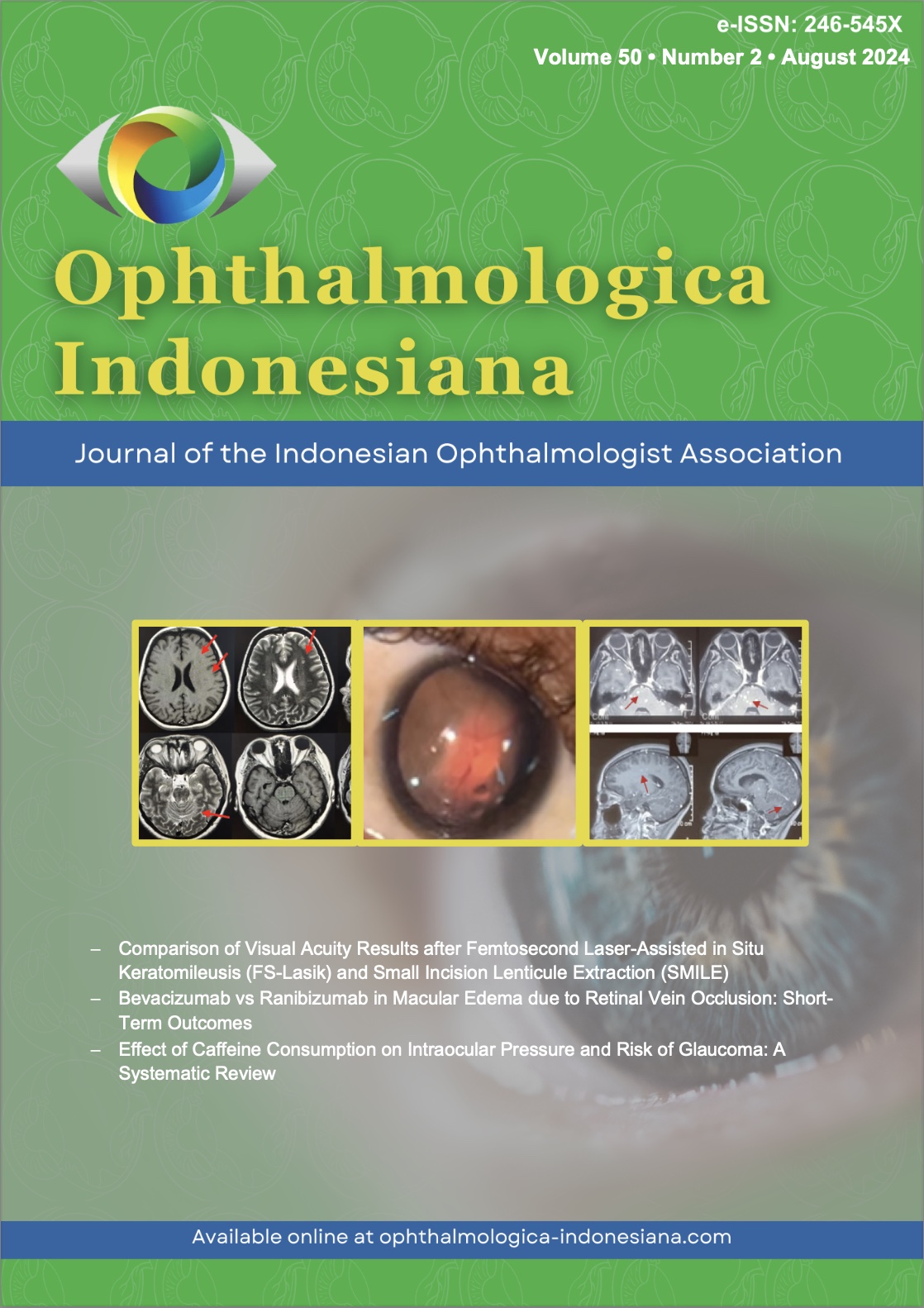INTERNUCLEAR OPHTHALMOPLEGIA IN MULTIPLE SCLEROSIS PATIENT
Abstract
Introduction: Internuclear ophthalmoplegia (INO) characterized by impaired adduction of the affected eye caused by a lesion in the medial longitudinal fasciculus (MLF). The common cause of INO is demyelinating disease including multiple sclerosis. INO arguably the most discrete localizing sign in medicine, has considerable value in predicting multiple sclerosis. Due to its high spatial resolution, MRI has allowed us to depict in vivo the anatomic organization of the human oculomotor nerve complex, the MLF, and related structures in the brainstem.
Case Report: A 48-year-old female presented with blurred vision of both eyes for 2 weeks, but then slowly resolved. Best corrected visual acuity presentation on both eyes were 20/20 with normal intraocular pressure (IOP). Adduction deficit observed on the left eye with no nystagmus. Convergence are not impaired in both eyes. Anterior segments was normal except minimal lens cloudiness in both eyes. Funduscopic examination result also within normal limit. Patient had undergone Computerised Tomography (CT-Scan) and the result was normal, no ischemic area or Space occupied lesion (SOL) or intracranial bleeding were found. Brain MRI showed bilateral optic perineuritis and multiple lesion in bilateral frontoparietalis and in the left side of the pons suggested multiple sclerosis.
Discussion: Impairment of adduction movement on the patient’s left eye caused by demyelinating plaque related multiple sclerosis on the left side of the pons as shown MRI imaging. Management in this patient is based on the underlying condition.
Conclusion: Internuclear ophthalmoplegia in this cases maybe caused by lesion in the medial longitudinal fasciculus could be related with multiple sclerosis.
Full text article
References
Seth V et al., Bilateral Internuclear Ophthalmoplegia in a Middle Aged Male due to Infarct. Journal of Clinical and Medical Images. 2020; V4(8): 1-2. ISSN: 2640-9615.
Portingale et al. A Case of Bilateral Internuclear Ophthalmoplegia: Aust Othopt J 2010 Vol 42(1).
Keane JR. Internuclear Ophthalmoplegia. Unusual Causes in 114 of 410 Patients. Arch Neurol. 2005. Vol.62.
Ghasemi N, Razavi Sh, Nikzad E. Multiple sclerosis: pathogenesis, symptoms, diagnoses and cell-based therapy. Cell J. 2017; 19(1): 1-10.
Chao J, et al. Internuclear Ophthalmoplegia as the First Manifestation of Pediatric-Onset Multiple Sclerosis and Concurrent Lyme Disease. Am J Case Rep.2020; 21:e925220.DOI:10.12659/AJCR.925220
Yeo SS, et al. Three-Dimensional Identification of the Medial Longitudinal Fasciculus in the Human Brain: A Diffusion Tensor Imaging Study. Journal of Clinical Medicine. 2020, 9, 1340. DOI: 10.3390/jcm9051340.
Bae YJ, et al. Brainstem Pathways for Horizontal Eye Movement: Pathologic Correlation with MR Imaging. RadioGraphics. 2013. 33: 47-59. DOI:10.1148/rg.331125033.
Fiester P, Rao D, Soule E, et al. (August 23, 2020) The Medial Longitudinal Fasciculus and Internuclear Opthalmoparesis: There’s More Than Meets the Eye. Cureus 12(8): e9959. DOI 10.7759/cureus.9959
Fiester P, Baig SA, Patel J, Rao D. An anatomic, imaging, and clinical review of the medial longitudinal fasciculus. J Clin Imaging Sci 2020;10:83.
Mitchell SV, Elkind MD. Pearls & Oy-sters: The medial longitudinal fasciculus in ocular motor physiology. Neurology. 2008;70: e57-e67.DOI:10.1212/01.wnl.0000 3106.40.37810.b3
Haider AS. BMJ Case Rep Published online: [please include Day Month Year] doi:10.1136/bcr-2016- 216503.
Rimayanti U, et al. Internuclear Ophthalmoplegia with ipsilateral Abduction Deficit: Half and Half Syndrome. Ophthalmol Ina. 2020;46(1): 29-33
Serra A, Chisari CG and Matta M (2018) Eye Movement Abnormalities in Multiple Sclerosis: Pathogenesis, Modeling, and Treatment. Front. Neurol. 9:31. doi: 10.3389/fneur.2018.00031
Wang C, et al. Axonal conduction in multiple sclerosis: A combined magnetic resonance imaging and electrophysiological study of the medial longitudinal fasciculus. Multiple Sclerosis Journal. 2014; 1-11.DOI: 10.1177/1352458514556301
McNulty JP, et al. Visualisation of the medial longitudinal fasciculus using fibre tractography in multiple sclerosis patients with internuclear ophthalmoplegia. Ir J Med Sci. 2016. DOI: 10.1007/s11845-016-1405-y.
Bijvank N, et al. Diagnosing and quantifying a common deficit in multiple sclerosis: Internuclear Ophthalmoplegia. Neurology. 2019. 92: e2299-e2308. DOI: 10.1212/ WNL.0000000000007499.
Bijvank N, et al. A model for interrogating the clinico-radiological paradox in multiple sclerosis: internuclear ophthalmoplegia. Eur J Neurol. 2021;28: 1617-1626. DOI: 10.1111/ene.14723.
Feroze KB, Wang J. Internuclear Ophthalmoplegia. [Updated 2021 Jun 30]. In: StatPearls [Internet]. Treasure Island (FL): StatPearls Publishing; 2022 Jan-.
Authors
Copyright (c) 2024 Fahrian Tirkal, Yunita Mansyur, Batari Todja Umar, Junus Baan, Yudy Goysal, Junus Baan

This work is licensed under a Creative Commons Attribution-NonCommercial-ShareAlike 4.0 International License.

